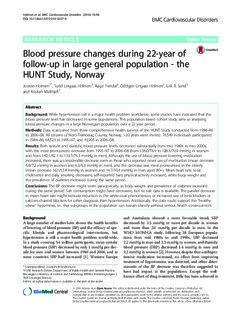| dc.contributor.author | Holmen, Jostein | |
| dc.contributor.author | Holmen, Turid Lingaas | |
| dc.contributor.author | Tverdal, Aage | |
| dc.contributor.author | Holmen, Oddgeir | |
| dc.contributor.author | Sund, Erik Reidar | |
| dc.contributor.author | Midthjell, Kristian | |
| dc.date.accessioned | 2016-09-02T11:16:03Z | |
| dc.date.accessioned | 2016-09-05T10:57:27Z | |
| dc.date.available | 2016-09-02T11:16:03Z | |
| dc.date.available | 2016-09-05T10:57:27Z | |
| dc.date.issued | 2016 | |
| dc.identifier.citation | BMC Cardiovascular Disorders 2016, 16 | nb_NO |
| dc.identifier.issn | 1471-2261 | |
| dc.identifier.uri | http://hdl.handle.net/11250/2404273 | |
| dc.description.abstract | Background:
While hypertension still is a major health problem worldwide, some studies have indicated that the blood pressure level has decreased in some populations. This population based cohort study aims at analysing blood pressure changes in a large Norwegian population over a 22 year period.
Methods:
Data is acquired from three comprehensive health surveys of the HUNT Study conducted from 1984–86 to 2006–08. All citizens of Nord-Trøndelag County, Norway, >20 years were invited: 74,549 individuals participated in 1984–86; 64,523 in 1995–97; and 43,905 in 2006–08.
Results:
Both systolic and diastolic blood pressure levels decreased substantially from mid 1980s to mid 2000s, with the most pronounced decrease from 1995–97 to 2006–08 (from 136.0/78.9 to 128.3/70.9 mmHg in women and from 140.1/82.1 to 133.7/76.5 mmHg in men). Although the use of blood pressure lowering medication increased, there was a considerable decrease even in those who reported never use of medication (mean decrease 6.8/7.2 mmHg in women and 6.3/5.3 mmHg in men), and the decrease was most pronounced in the elderly (mean decrease 16.1/12.4 mmHg in women and 14.7/10.4 mmHg in men aged 80+). Mean heart rate, total cholesterol and daily smoking decreased, self-reported hard physical activity increased, while body weight and the prevalence of diabetes increased during the same period.
Conclusions:
The BP decrease might seem paradoxically, as body weight and prevalence of diabetes increased during the same period. Salt consumption might have decreased, but no salt data is available. The parallel decrease in mean heart rate might indicate reduction in the white-coat phenomenon, or increased use of beta blockers or calcium channel blockers for other diagnosis than hypertension. Additionally, the data could support the “healthy obese” hypothesis, i.e., that subgroups in the population can sustain obesity without serious health consequences. | nb_NO |
| dc.language.iso | eng | nb_NO |
| dc.publisher | BioMed Central | nb_NO |
| dc.rights | Navngivelse 3.0 Norge | * |
| dc.rights.uri | http://creativecommons.org/licenses/by/3.0/no/ | * |
| dc.title | Blood pressure changes during 22-year of follow-up in large general population - the HUNT Study, Norway | nb_NO |
| dc.type | Journal article | nb_NO |
| dc.type | Peer reviewed | nb_NO |
| dc.date.updated | 2016-09-02T11:16:03Z | |
| dc.source.volume | 16 | nb_NO |
| dc.source.journal | BMC Cardiovascular Disorders | nb_NO |
| dc.identifier.doi | 10.1186/s12872-016-0257-8 | |
| dc.identifier.cristin | 1368440 | |
| dc.description.localcode | © 2016 Holmen et al. Open Access. This article is distributed under the terms of the Creative Commons Attribution 4.0 International License (http://creativecommons.org/licenses/by/4.0/), which permits unrestricted use, distribution, and reproduction in any medium, provided you give appropriate credit to the original author(s) and the source, provide a link to the Creative Commons license, and indicate if changes were made. The Creative Commons Public Domain Dedication waiver (http://creativecommons.org/publicdomain/zero/1.0/) applies to the data made available in this article, unless otherwise stated. | nb_NO |

